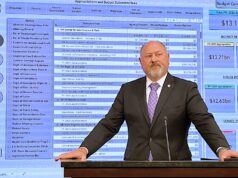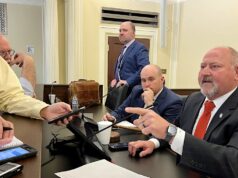

(Editor’s note: This story was authored by Paul Monies of Oklahoma Watch and appears here in accordance with the non-profit journalism organization’s republishing terms.)
A cash crunch that emerged over the summer at the Oklahoma State Health Department goes beyond the state’s current budget shortfall and has caused the department to reach out to public health agencies in Oklahoma and Tulsa counties for help in shoring up its finances.
The effort comes as the department has ordered furloughs of some employees and called in State Auditor and Inspector Gary Jones for a special audit of its finances. Earlier this week, the department announced cuts to several contracted services, including programs to prevent child abuse.
The shortfall is so severe that the department activated its incident command structure, a management response typically used for public health emergencies, such as outbreaks of the mosquito-borne Zika virus or food contamination cases.
Reduced budgets
At board meetings in June and July, department leaders provided financial updates that didn’t appear to raise alarm bells. The updates noted a 2.8 percent reduction in state appropriations for fiscal year 2018, along with targeted cuts to several programs totaling $229,000.
But at an August retreat in Stillwater, the board heard about a shortfall for Fiscal Year 2018 that went far beyond the expected appropriations cut.
“This issue began in prior state fiscal years, also leaving the agency with prior year obligations that need to be made current,” according to the August presentation.
When it announced job furloughs in September, the department said it estimated a shortfall of more than $10 million. Leaders blamed the gap on the loss of federal funds, higher costs and cumulative cuts to state appropriations totaling 30 percent since 2009.
Unclear causes
In a statement to Oklahoma Watch, OSDH said its financial updates to the board in mid-summer were a work in progress. The department declined to provide additional detail on the causes of the $10 million gap, which represents one-fifth of the agency’s state appropriations.
“The budget process is an ongoing evaluation of grants, programs and funding streams, and was not set in stone in July,” spokesman Tony Sellars said in an email. “Through continued research and monitoring, OSDH provided an update to the budget forecast.”
Leaders of the combined city-county health departments in Oklahoma and Tulsa counties were surprised when OSDH summoned them to a meeting last month about testing and medication costs for sexually transmitted diseases. They were told residents of their counties were seeking treatment in adjacent county health clinics that are state-funded.
Public health programs in Oklahoma and Tulsa counties are affiliated with the state but operate independently as combined city-county health agencies. Other local health departments are overseen by the state.
Gary Cox, executive director of the Oklahoma City-County Health Department, said the state’s request to reimburse costs for sexually transmitted disease testing was unprecedented. The state health department is seeking about $868,000 for STD testing done for Oklahoma County residents this fiscal year.
“Traditionally in Oklahoma, we’ve taken care of whoever shows up at the door,” Cox said in an interview. “In public health, that’s just the way we do it. That’s a big departure from 50 years of public health in Oklahoma, to change the way we do business.”
Cox took the information to his board, which unanimously voted to decline the state health department’s request. In a letter obtained by Oklahoma Watch, the city-county health department requested information about how state health department resources are distributed to all 77 counties.
“We think it important to not only look at STD funding but all public health funding to get an overall accurate financial and service delivery picture,” the Sept. 29 letter said. “Since there appears to be a financial crisis at OSDH, we recommend the immediate establishment of a joint commission with representatives from OSDH, County Health Departments, Tulsa Health Department and Oklahoma City-County Health Department, to look at public health delivery in Oklahoma, prioritization of core public health and shared services in both rural and metro regions.”
The board of directors at the Tulsa City-County Health department had a similar suggestion when the state proposed charging $700,000 for STD testing and medicine starting Nov. 1. The billing request was made by Julie Cox-Kain, senior deputy commissioner of the state health department.
“Julie mentioned that OSDH has been discussing these issues at meetings and off-site retreats for months,” said a Sept. 27 letter from Tulsa health department to the state. “Unfortunately, THD was not invited to be part of those discussions, and yet we have been given approximately 40 days to respond before we begin receiving bills from OSDH.”
Bruce Dart, executive director of the Tulsa City-County Health Department, said the billing request from the state came several months into the fiscal year and after its budget had been approved by the county’s excise board.
“It’s an impossible request for us to meet,” Dart said. “We feel like we don’t have the full story. Suddenly, there’s a budget crisis. Overall, Oklahoma has been dealing with budget shortfalls for a while, but we have been careful.”
Sellars said the state continues to have discussions with Oklahoma and Tulsa counties, contractors and other groups in order “to provide services in a fiscally responsible manner.
“In the current climate, it is imperative for all parties to work together on steps to make public health services stronger,” Sellars said in the statement. “Toward that goal, OSDH is analyzing all aspects of our financial operation. This is a long-term process and it would be premature to go into specific detail at this time about any future plans.”
Controlling costs and untoward effects
The furloughs – two days per month – will affect all employees at the agency making annual salaries above $35,000. The furloughs start Oct. 29. Other personnel actions include buy-outs, or voluntary out benefit offers (VOBOs).
“The agency is exploring all statutory options in resolving the current budget situation,” Sellars said. “There have not been any additional plans finalized beyond the furlough.”
Meanwhile, vendors whose state contracts were canceled said they are scrambling to fill the funding gaps. The department said it expected to save $3 million from cuts to federally qualified health centers and the Oklahoma Child Abuse Prevention Program. The health center program reimburses medical expenses not covered by insurance or other funding sources. The child abuse prevention programs support in-home visits for new parents.
Parent Promise, a program which has contracted with OSDH for child abuse prevention programs since 1995, was notified in late August it would be awarded a new five-year contract for services. Less than two months later, the agency’s $276,000-per-year contract was canceled.
Employees at Parent Promise visit client homes to provide guidance to parents about child development and how to constructively deal with stress that could turn into neglect or abuse.
Sherry Fair, Parent Promise’s executive director, and leaders at the Oklahoma City and Tulsa county health departments questioned the sudden cuts at the state health department. The ongoing special legislative session to address a $215 million shortfall affected three main agencies: the Department of Mental Health and Substance Abuse Services, the Oklahoma Health Care Authority and the Department of Human Services.
“It’s confusing as to why the Health Department has to make these drastic cuts,” Fair said. “It wasn’t among the three departments that were affected by the cigarette fee that was struck down.”
(Correction: This story has been updated to remove an incorrect reference to the number of health departments in the state of Oklahoma. Oklahoma Watch and NonDoc regret the error.)




















